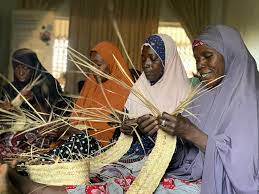
Soya bean is one of the most common food crops grown and consumed in many parts of Africa. Soy bean (Glycine Max) is classified as an oilseed rather than a pulse. It is a species of legume native to East Asia (China) and still remains a major crop there till today. Prior to its use for fermented food products, soybean was considered sacred for use in crop rotation as a method of fixing nitrogen.
The bean on dry weight basis is twenty-nine percent (29%) oil, forty percent (40%) protein, thirty-five percent (35%) carbohydrate and about five percent (5%) ash. Its protein is heat stable, thus allowing it to withstand high temperature during cooking.
Though production and utilization of soy bean started in the Orient as far back as the 11th Century, this ancient crop became grown in other parts of the world just in the 20th Century. It was first introduced in Europe in the 1700s and in America in 1804 (Katz, 1998).
It was introduced to Africa from China in the late 19th Century and is now widespread across the continent including Nigeria. The earliest known cultivation of soy beans in Africa was in 1896, when they were grown in Algeria, at a government botanical station and later in 1903, when they were grown in South Africa. From 1908, there has being a dramatic and tremendous increasing interest in growing Soybean in Africa, as Europe for the first time began import large quantities of Soybean in response to severe shortages and prices of oil.
By 1982, Soybean and Soy foods, though still played a very minor role in Africa have been identified as having great potentials in arresting the declining per capital food production as well as protein and calorie consumption in the Continent including Nigeria.
Soy bean was introduced into Nigeria in 1908; it was first planted in Ibadan, Oyo State. Initially the crop was cultivated for export with the support and encouragement of Groundnut Board. Nigeria presently produces about five hundred thousand (500,000) MT of Soybean annually making it one of the largest producer’s of the product on the African continent. Soybean is a legume which is produced in most the middle belt of the country with Benue state accounting for about forty percent (45%) of the total production in country.
Soya Bean is a leguminous crop whose importance and economic benefits cannot be over emphasized. Products that can be gotten from Soya Bean include Soy Cake, Soy oil, Full Fat Soya, Soy meal, soy meal, soy flour, soy milk, tofu, textured vegetable protein amongst other things.
Over the last twenty to thirty (20-30) years, consistent improvements in average yield levels and reductions in production costs have steadily improved the competitive position of soybeans among arable crops. Among oil crops, soybean covers a leading role at the global scale: today, soybeans account for about thirty-five percent (35%) of total harvested area devoted to annual and perennial oilcrops. The crop’s share in global oilseed output is estimated at over fifty percent (50%).
Soybean cultivation is highly concentrated geographically, with only four countries - USA, Brazil, Argentina and China - accounting for almost ninety percent (90%) of world output. Asia - excluding China - and Africa, the two regions where most of the food insecure countries are located, together account for only five percent (5%) of production. Among countries classified as undernourished, only India and Bolivia are significant producers of soybeans.
Soybean is a high value and profitable crop. The economic viability of soy production is determined by the commercial utilization of its sub-products, meal and oil, which, respectively, account forabout two thirds and one third of the crop’s economic value.
Soyoil and meal are consumed worldwide as food and animal feedstuff respectively. Soymeal accounts for over sixty percent (60%) of world meal production (vegetable and animal meal) and occupies a prominent position among protein feedstuffs used for the production of feed concentrates.
Soybean oil is the second most important vegetable oil (after palm oil); it accounts for twenty-five percent (25%) of global vegetable/animal oils and fats consumption. The widespread use of soybean oil in particular as edible oil is due to it’s plentiful and dependable supplies, its competitive price, and its neutral flavour and stability in both unhydrogenated and partially hydrogenated form.
Moreover, the rapid rise in the demand for compound feed - und thus soya meal - has contributed considerably to the rise in soyoil production. Oil palm is a major competitor with soybean oil. Although the palm produces far more oil per unit area than soybean, soybean’s role is expected to be secure because soya meal is in huge demand and oil is a very lucrative by-product. It is also true that oil palm is generally grown in different ecologies than soybean, so there is a certain amount of geographical complementarity.
The United States, Brazil, Argentina and Paraguay are the biggest producers and exporters of soybeans in the world, concentrating eighty-five percent (85%) of total production and ninety-four percent (94%) of total exports in 2010/11 fiscal year. China is the biggest importer of soybeans (sixty percent (60%) of total imports) followed by the European Union, Mexico, Japan and Taiwan.
Nigeria presently produces about five hundred thousand (500,000) tons of soya bean annually. Nigeria’s installed annual soybean crushing capacity is estimated at approximately six hundred thousand (600,000) MT. An estimated two hundred and fifty-five thousand (255,000) tons of soybeans were crushed in MY 2010/11, representing only forty-two percent (42%) of installed processing capacity. Eight (8) large processors account for nearly sixty percent (60%) of Nigeria’s soybean crushing industry.
Industry sources forecast crushing to rise to two hundred and seventy-one thousand (271,000) tons in MY 2011/12 on account of the anticipated increased soybeans production. Soybeans are crushed to obtain oil (for industrial and refined for food use), soybean meal/cake for animal feed and soy protein for human consumption.
Nigeria currently produces soybean worth $85 million in the international market and though most of the nation’s soybean is consumed locally where they are used in the production of soymilk and specially formulated foods to help malnourished infants and children, the international market for the product is growing and sustainable.
Because of it numerous uses, soya beans are in great demand and this opens an opportunity for interested investors to export the product.
The return on investment on the trading of soya beans is estimated between ten to fifteen percent (10%- 15%).






















